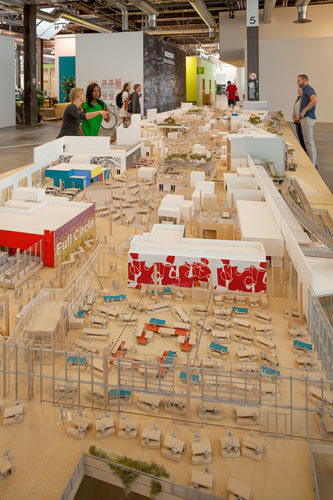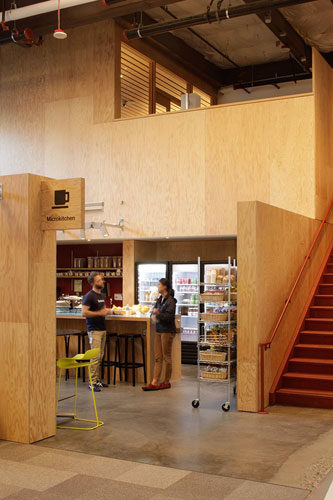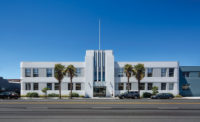Menlo Park, California
The challenge presented by Facebook for its first ground-up building could have been from an architecture school studio assignment: design something cool on a modest budget for a client in need of fresh ideas. It was catnip to architect Frank Gehry, who in early 2012 was overseeing the construction of the Fondation Louis Vuitton, a glass sculpture with a seemingly limitless budget. But first he had to convince Facebook CEO Mark Zuckerberg to let him compete.
By all accounts, Facebook was not interested in hiring a marquee architect to make a structural statement. The company downplays corporate branding and discourages 'Facebook blue' on its existing 57-acre Menlo Park campus, at the southern edge of San Francisco Bay. The company of intense young programmers didn't want a space that would define them. 'We were used to being hermit crabs, moving into someone else's space and adapting it,' says John Tenanes, Facebook's vice president of global facilities and real estate. When Gehry first talked to Zuckerberg, a connection made by friends in high places, the company had already hired Gensler to extend its existing 57-acre campus with a set of four low-rise buildings accompanied by a parking garage. 'I think it was a learning curve for Mark,' says Gehry, who is quick to mention that Bilbao was built for $300 a square foot. 'He thought that to build for those prices, he had to have generically produced architecture. But it turned out that he didn't have to.'
Zuckerberg visited Gehry's own office, a renovated warehouse in Los Angeles, and liked the open daylit space, where architects could gather around large physical models. Gehry assured the young corporate head that he could design something to suit the company's budget and tight timeline, and won the commission.
For the campus extension'located on a narrow 22-acre site, adjacent to the older Facebook complex'the design team created a 1,500-foot-long structure with a continuous workspace on one floor. 'Every time we met with Mark at his office, more [partitions] would be torn down, so it was pretty clear how they liked to work,' says Craig Webb, design partner at Gehry Partners and the project designer. The steel structure sits on a reinforced-concrete podium supported by concrete columns, forming an at-grade, open-air parking garage. Like Gehry's office, the workplace has a lofty height of 25 feet. Based on feedback from city building officials, the structure, clad primarily in stucco and glass, is articulated into four primary masses to reduce its scale.
Nicknamed MPK20 (short for Menlo Park building 20), the elongated building is said to feature the world's largest open-plan office, yet it feels rather contained inside. Like many tech environments, it is organized into 'neighborhoods,' with clusters of desks interspersed with enclosed private conference rooms of various sizes. 'The dilemma was how to make this 400,000-square-foot space not feel like an automobile factory,' says Webb. 'We created a little city under the roof'we practiced indoor urbanism.'
This 'city' is designed without a regular office grid, giving it an ad-hoc, organic quality. A meandering path runs down each side of the building, with several cross-streets. The tall ceiling height also accommodates small mezzanine areas that offer more secluded work environments. 'This is the new paradigm for creative office space,' says Webb. Should the rumblings of discontent with open floor plans someday grow into a roar, the benefit of starting with a large open shell is that there is the flexibility to adapt.
Responding to Facebook's preference for raw, unfinished space'one of the company's tenets is that nothing is ever finished'the design team revealed everything overhead, including large-scale metal ductwork, custom skylight diffusers, and power and network cables that dangle down to the desks (for easy reconfiguring). Adding to the utilitarian ethos, exposed structural elements still have their construction markings on them, circulation routes are concrete (albeit polished), and conference rooms are simple boxlike gypsum board structures that could be torn down without much fuss. A bright and spacious cafeteria, anchoring one end of the building, offers the prime perk: three free meals a day. Here, everything from duck-confit pot pie to whole-wheat mango scones is made on-site in a large open kitchen. (Easy access to food is a big part of the design, with 14 coffee-dispensing micro-kitchens scattered throughout, two eateries under construction on the opposite end, and a grilled-cheese and potato bar planned for the roof.)
According to Gehry, Facebook did splurge a little on the rooftop park, which added about 10 percent to the overall cost. Initially proposed by the architect's team as a sustainability measure, the concept expanded into a full-fledged park. The '-mile loop with numerous branching paths accommodates 'walking meetings,' a popular way to conduct one-on-one confabs in Silicon Valley. When you are in the rooftop park, buffeted by the winds coming off the Bay, it feels like being on the crest of a hill. Buckling-restrained braces are in place to resist seismic forces. These supports also help manage the load of soil, plantings'including full-sized trees'and up to 5,000 people. Three glass-walled sunken patios break through the roofline and provide glimpses of the greenery from within.
While the architects were 'constantly trading amenities' to meet the budget, says Gehry, there are several distinct moments where the architecture asserts itself. The main visitors entrance, Lobby 4, is a triple-height space clad in stainless-steel panels. Within the sunlit volume, a sculptural staircase is clad in plywood: a humble material used to glorious effect.
Upstairs, the overall atmosphere is one of calm and quiet. 'A couple of hours after we moved in, people were hard at work,' says Tenanes. 'The space felt so natural to everyone.' One flight down, on the main office floor, an employee printout on one wall reads: 'Facebook Life Event: Saw Frank Gehry in a Frank Gehry building.
PeopleClient/Owner: Facebook
Architect:
Personnel in architect's firm who should receive special credit:
Project Team: Architect of record: Gehry Partners, LLP
Engineers
Consultant(s): General contractor: Level10 Construction
Photographer(s): Size: 433,000 square feet Cost: withheld Completion date: March 2015 |
Products
Structural system
Exterior cladding Metal Panels: Stainless steel panel cladding, non-directional angelhair finish:The Rimex Metals Group Metal/glass curtain wall: Kawneer 1600 Wall System / Viracon VE1-2M insulating glass with ceramic frit
Roofing Elastomeric: Siplast PC-227
Modified Bituminous built-up roofing: Siplast Paradine
Windows Metal frame: Kawneer 8400TL
Glazing Skylights: Viracon VE1-2M insulating glass
Doors Metal doors: Curries
Wood doors: Flush: Eggers Industries Sliding doors: Horton Sectional overhead doors: Arm-R-Lite
Fire-control doors: Cookson
Hardware Closers: LCN Exit devices: VonDuprin Pulls: Rockwood
Interior finishes Suspension grid: USG ClimaPlus Radar
Acoustical wall paneling: Ecoustic panels Cabinetwork and custom woodwork: Douglas fir plywood, Isec Paints and stains: Kelly-Moore Paints Paneling: Douglas fir plywood, Isec Plastic laminate microkitchen countertops: Abet Laminati Restroom floor and wall tile: Royal Mosa porcelain 6x12 wall tile, Royal Mosa 12x24 porcelain floor tile Single user restroom floor and wall tile: Royal Mosa 8x24 ceramic wall tile, Royal Mosa 12x24 porcelain floor tile Recycled Wood flooring: Pioneer Millworks Carpet: Interface Resilient sheet flooring in elevator cabs: Mondo Ramflex Resinous Flooring: Dex-o-Tex Decor-flor
Furnishings Reception furniture: Custom by Isec Fixed seating: Custom by Isec Chairs: Herman Miller Aeron Tables: Custom Mash Industries Upholstery: varies
Lighting Downlights: Targetti Conference room lighting: Finelite and Kurt Versen Exterior: Bega and Targetti Dimming System or other lighting controls: Lutron and ETC
Conveyance Accessibility provision: McKinley Elevator Corporation
Plumbing
Energy
Other unique products that contribute to sustainability: |
























